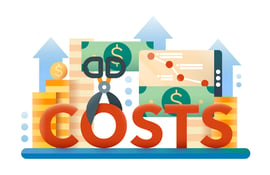[su_youtube url="https://www.youtube.com/watch?v=i5B57g89dfc"]
It is very rare for a company to cut costs and achieve profitability
Cutting costs without reassessing the strategy first is like taking heavy objects out of a car because a tire is losing air. And trying to add sales revenue to that same company is like trying to put air back in that tire without fixing the leak. Unintended consequences of cost cuts are myriad. The most important ones are that customers are dissatisfied because they're not getting the service they used to get because you've cut the wrong cost. And that's driven because the employees leave that are capable of leaving, so your best employees leave, your customer service deteriorates, your sales decline, and more employees leave. It's a vicious cycle and you need to avoid it.
And how do you avoid cutting the wrong costs?
How do you avoid it? How do you make that change? The way you do that is to understand who your most profitable customers are and what your most profitable products are. And at a high level, quickly assessing who your least profitable customers are and your least profitable products and cut the costs that support those activities first, freeing up revenue and resources to provide better service to your best customers and take care of your best employees. And there's always pressure to act quickly. The most important thing to do is quickly identify, even at a high level, the least profitable customers and least profitable products and stop spending money on those things.
Free up resources
The resources you free up by doing that will allow you to then focus more attention on your best customers and retain your best employees. How do you do it? You do an analysis, understand your costs, understand which customers are willing to make changes to help you improve your profitability and jettison those customers that are not willing to help you become a better company for them.
Think about creating a bell curve of your company's profitability
On the left-hand side of the bell curve, 10% or 15% of your least unprofitable customers. On the right-hand side, 10% or 15% of your most profitable customers. The focus here is to eliminate that whole pointy end of the bell curve on the left. Get rid of all your unprofitable customers and then move all the rest of the customers to the right, towards a more profitable status. There's no time like the present to perform this analysis. The Optima team can provide a very different perspective of your business then you've ever seen. And with that perspective, we can help you make the tough decisions that allow you to become more profitable quickly and move forward to a longterm profitable future. Optima Office can help you make wise cost-cutting decisions and avoid unintended consequences.
Call us today at 858.283.1234.


